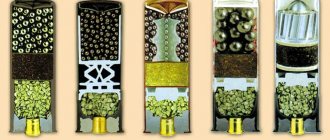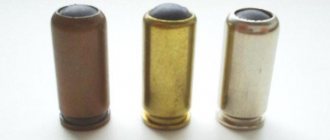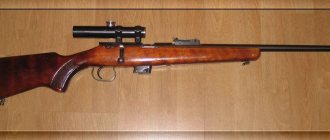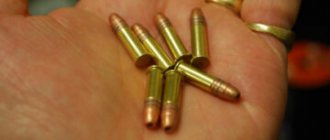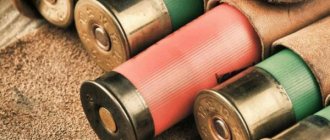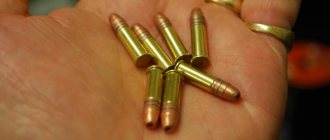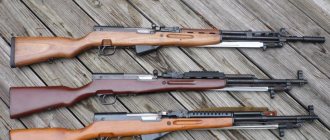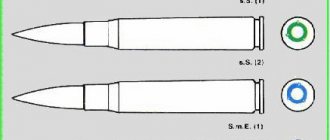Classification
Since a mismatch in the capabilities of the mounting cartridge can cause damage to the powder pistol, the classification of these consumables is carried out simultaneously according to several parameters:
- By color. It determines the charge power in joules, and the marking itself is made on the conical tip of the cartridge.
- In height and diameter. There are long (D) and short (K) cartridges. The mounting tool uses 5.6×16, 6.8×11 and 6.8×18 mm cartridges.
- By cartridge number, which determines the mass of the powder charge.
- According to the packaging method. For example, for repeating or automatic pistols, cartridges are supplied only in a belt.
All types of mounting chucks used in construction work have a standard design and consist of the following parts:
- A steel casing containing a charge of smokeless powder. In K series cartridges, gunpowder fills the entire space of the cartridge case, and in D series cartridges - only its bottom part;
- Capsule;
- A wad made of pressed gunpowder that holds the percussion compound in the cartridge case;
- Crimping of the sleeve from above with corresponding markings by color.
Materials and technical requirements for the production of mounting cartridges are regulated by the requirements of TU 3 -795-94.
Markings on small arms cartridges
MARKET MARKING
The use of a large number of different types of cartridges in modern automatic weapons, usually similar in appearance, has led to the use of special markings to distinguish them from each other. Therefore, one of the sources of information about cartridges are markings in the form of distinctive colors, signs and inscriptions applied both to the components of cartridges and to packaging with cartridges.
Markings on small arms cartridges may contain the following basic data: 1. Service marks on the bottom parts of the cartridges - place of manufacture (country, enterprise or manufacturer); type (name) and caliber of cartridge; manufacturing time of the cartridge or cartridge case; sleeve material; purpose of the cartridge; the type or model (sample) of the weapon for which the cartridge is intended. 2. Painting of cartridge elements (bullets, primers, bottom parts of cartridge cases) - type of cartridge, its purpose, some features of the device. 3. Labels (tags) - the same data contained in service marks, as well as some information about the elements of cartridges and their ballistic characteristics, applied to packaging - on wooden boxes, metal boxes, moisture-proof bags, cardboard boxes, paper bags.
Markings on cartridges, as well as similar designations on other industrial products, originate from the marks of craftsmen, which have long been placed on various goods (weapons, pottery and jewelry, etc.). Currently, they perform two functions: technical, informational and advertising, and are a type of trademark.
Brands are symbols in the form of letters, numbers, drawings, embossed on the surface of cartridge elements. They are service and control. Service marks contain data about the manufacturer (manufacturer), date of production, time of manufacture of cartridges, some design features, purpose, and may also contain other data characteristic of certain periods of time of their activity or always characteristic of manufacturers of a certain country. For this purpose, on the outer surface of the bottom of the sleeve, on diametrically opposite sides, the plant number is indicated - for domestic cartridges or the name of the company (its conventional index) - for foreign-made cartridges, as well as the year of manufacture. Control marks indicate passing technical control. They are usually placed only on elements of powerful ammunition (artillery, etc.).
Depending on the types of cartridges and their purpose, one or another content may predominate in the marking. For example, on military cartridges it contains mainly technical information, and on hunting and sporting cartridges it often contains advertising information. An advertising character is given to it due to both the visual form (types of fonts, decorative elements, etc.) and the content (catchy and memorable names, proper names, etc.), emphasizing the quality of the products and their popularity.
Cartridge markings, which include stamps, labels and conventional coloring of elements, are systems of conventional signs containing certain information necessary primarily to distinguish between the types and purposes of cartridges.
Labels (labels) are markings applied to cartridge packaging (boxes, cartons). They are designed to obtain information about cartridges without opening the packages.
The coloring of cartridge elements is intended to provide an easily perceived distinctive feature of the type and purpose of the cartridges. At the same time, it serves as a means of protection against corrosion.
In domestic small arms cartridges, the coloring of the head part (top) of the bullet is adopted as the simplest in terms of technology. For example, an armor-piercing incendiary bullet is painted black and red; tracer - green; armor-piercing-incendiary-tracer - in purple and red; incendiary (targeting-incendiary) - red; with a reduced initial speed - black and green, etc. Ordinary bullets usually do not have a distinctive color. A similar principle of different colors of cartridges with different bullets has been adopted in a number of armies of foreign countries. Sometimes the cartridge primer and the junction of the bullet and the cartridge case are colored. In this case, coloring is used not only as a distinctive feature of cartridges with different bullets, but also as a way to ensure the tightness of cartridges. This method of painting is less convenient not only technologically, but also causes certain inconvenience when visually determining the nomenclature of the cartridge.
Cartridge marking systems are different for different countries, times, manufacturers, and types of cartridges.
CASE MARKING
Basic information contained in the marks on small arms cartridges of cartridges from some manufacturing countries.
Manufacturers:
Soviet / Russian
Contents of information:
abbreviated name or symbol of the cartridge manufacturer, time (year) of manufacture of the cartridge case.
English, Canadian, Australian:
abbreviated name or symbol of the manufacturer of the cartridge or cartridge case; type (brand) of cartridge.
French:
abbreviated name or symbol of the company supplying the metal of the sleeve; time (year and quarter) of manufacture of the sleeve.
German:
abbreviated name or symbol of the sleeve manufacturer; time (year) of manufacture of the sleeve; symbol of the sleeve material; conditional batch number of cartridges.
Italian:
state-owned enterprises: full or abbreviated name of the manufacturer; time (year) of manufacture of the sleeve; State Comptroller's initials; private enterprises: full or abbreviated name of the manufacturer; time (year) of manufacture of the sleeve.
Japanese:
abbreviated name or symbol of the manufacturer; caliber; abbreviated designation of the year of manufacture of the sleeve (according to the Japanese calendar) and the quarter of manufacture.
Stamps on cartridge cases are inscriptions (alphabetic and digital texts) and drawings (symbols, ornaments, etc.), usually made in depressed, less often in convex relief. Their contents are the full, abbreviated (abbreviations, abbreviations of individual words, etc.) or expressed by symbols names of manufacturers (company, enterprise), country, geographical location or administrative region where they are located. As a rule, the texts are made in the language of the country where the manufacturer operates, however, on cartridges produced for the foreign market or for foreign orders, stamps may be made in other languages.
In terms of artistic design, marks can be either simple, devoid of decoration, or complicated due to various artistic elements (symbols, ornaments, etc.).
The marks of the same manufacturer may differ completely or partially depending on the time of manufacture of the cartridges, their types and purposes. Sometimes marks may contain the designations of two manufacturers, one of which refers to the manufacturer of the cartridges, and the other to the manufacturer of the cartridge case or fitting company. Often the cartridges contain only the marks of their manufacturers.
Manufacturer's marks on cartridge cases are sometimes replaced by designations and trademarks of cartridge customers (usually trading companies). Finally, there may be no marks on the cartridges at all.
Fragments of stamps containing data on the time of manufacture of cartridges or cartridges, name (type, brand, sample), caliber, weapon for which the cartridge is intended, have the following options and features.
Manufacturing time is indicated in different ways: the year in full, the last two or three digits of the year, the year and quarter, or the month. The year can be indicated by a conventional sign, for example, a letter. In accordance with the nationality of the manufacturer or customer of the cartridges, the time of their manufacture can be indicated according to the chronology adopted in certain countries or a group of countries, as well as according to the time of an important historical event in the life of the country. In some cases, the stamps reflect memorable dates in the activities of the cartridge manufacturer (company anniversary, etc.).
The production time is not always indicated in the stamps on the cartridges. In these cases, it can be roughly judged by the name of the manufacturer or the version of its brand, especially if they changed during certain periods of activity.
The name (type) of a cartridge is usually designated according to that given to it in the country where it was developed or first issued. It can also be designated in accordance with the military name or number assigned when the cartridge was adopted for service in a given country. Sometimes it is indicated by reference, by indicating the number assigned to the cartridge in the company’s catalog.
The caliber of a cartridge is usually indicated in the system of measures (metric or English) that was used to develop the cartridge or accept it for production. As a rule, it is not recalculated, regardless of what system of measures the manufacturer uses. An exception is allowed only for some common cartridges.
For some older types of cartridges, mainly American, the caliber may be indicated by an indicator located in a series of numbers that indicate such characteristics of the cartridge as its caliber in fractions of an inch, the mass of black powder and bullets in grains. This designation system continues to this day for those cartridges of older types, the production of which is still ongoing, although they have not been equipped with black powder for a long time. This protects the buyer/owner of an old weapon from mixing these cartridges with new types of cartridges that are similar in design (shape, size), but different in their ballistic characteristics.
Stamps on cartridge cases sometimes contain a number of other designations indicating the material of the cartridge case, the design of the capsule, the special purpose of the cartridge, as well as other information (manufactured by army order, patent issued to the manufacturer, etc.).
In domestic cartridges, at the end of the bottom part of the cartridge case, a marking containing the manufacturer’s reference number and the year of manufacture (the last two digits of the year) is stamped. In the period 1949–1954, the year of manufacture was conventionally designated by a letter (from “A” to “E”).
Signs in the form of two diametrically located five-pointed stars can be additionally applied to the bottom parts of individual nomenclatures of domestic sleeves.
For 7.62-mm rifle cartridges intended for firing from the ShKAS aircraft machine gun, an additional letter “Ш” was applied to the end of the bottom of the cartridge case, and the igniter cap was coated with red varnish.
MARKING OF BULLETS
The marking on the head of the bullets is applied in the form of a distinctive color.
Type of cartridge: cartridge with armor-piercing incendiary bullet B-32.
The distinctive color on the head of the bullet is black and red.
Cartridge with armor-piercing incendiary bullet BZ: black and red.
Cartridge with armor-piercing incendiary bullet BS: black and red - to the point where the cartridge case is crimped.
Cartridge with armor-piercing incendiary bullet BS-41: black and red - to the point where the cartridge case is crimped.
Cartridges with armor-piercing incendiary tracer bullets BZT-44 and BZT: purple and red.
Cartridge with armor-piercing incendiary tracer bullet BST: purple and red - to the point where the cartridge case is crimped.
Cartridges with incendiary bullet Z and sighting-incendiary bullet PZ: red.
Cartridge with instantaneous incendiary bullet MDZ: red - to the point where the cartridge case is crimped.
Cartridge with T-45 and T-46 tracer bullets: green.
Cartridge with reduced bullet speed US: black and green.
Rifle cartridge with LPS steel core bullet: silver (painting has not been applied since 1978).
Rifle cartridge with light bullet L: without distinctive coloring.
Rifle cartridge with heavy bullet D: yellow.
High-pressure HP cartridge: yellow - to the point where the cartridge case neck is crimped (bullets of 7.62 mm cartridges of the 1943 model and rifle cartridges, which have a special shape, do not have a distinctive color).
Cartridge with enhanced ultrasonic charge: black - to the point where the cartridge case is crimped.
Model cartridge: white.
In addition to the distinctive coloring, on domestic cartridges, with the exception of those indicated below, around the circumference of the joints of the cartridge case with the bullet and the igniter capsule, a thin layer of varnish is applied in the form of a red rim (ring) - a sealant, which is a solution of resin in an organic solvent, tinted with a red dye .
To seal blank large-caliber machine gun cartridges of 12.7 mm and 14.5 mm caliber around the circumference of the joints of the cartridge case with the cap and the igniter primer, a sealant tinted with green dye is used.
The sealant is not applied to 7.62 mm TT pistol and Nagan revolver cartridges and to 7.62 mm rifle blank cartridges, as well as to cartridges with enhanced charge and high pressure, except for cartridges of 12.7 mm and 14 calibers, 5 mm.
The cartridge is sealed to prevent gun grease (oil) and moisture from penetrating into the charging chamber.
MARKING OF PACKAGING WITH CARTRIDGES
The marking of cartridge packaging consists of colored distinctive stripes, signs and inscriptions in black.
Markings on packaging with cartridges are applied: on a wooden box - on the lid and on one side wall; on a metal box - on the lid; on a moisture-proof bag - on the longitudinal sides of the bag; on a cardboard box or paper bag - on one side of the box or bag.
Marking on packaging is applied by stenciling, stamping, printing or a special marking machine.
The box marking contains: on the lid - weight (gross, kg); a transport sign indicating the category of cargo (the number “2” in an equilateral triangle, the apex of which is directed towards the fastening of the hinges). Since 1990, instead of the cargo category (the numbers “2”), a conventional dangerous goods number and a danger sign or classification code, characterizing the transport danger of the cargo in accordance with GOST 19433-88, began to be applied in an equilateral triangle. The danger sign is printed on a paper label, which is glued to the lid of the box.
Boxes with training cartridges are not marked with a cargo discharge sign or a dangerous cargo symbol number or a marking indicating the transport danger of the cargo.
The following symbols of cartridges are applied to the side wall of the box with cartridges for small arms: the inscription “OBR. 43", "SNIPER", "RIFLE", "PISTOL"; batch number; year of manufacture (last two digits); conditional number of the manufacturer; Marking of a batch of gunpowder; number of cartridges; number of seals (for 7.62 mm cartridges model 1943 with a bullet with a reduced velocity); a distinctive stripe, sign or inscription characterizing the type of bullet and (or) cartridge.
On the side wall of the box containing moisture-proof bags with cartridges, the inscription “MOISTURE-PROOF PACKAGES” is additionally applied in two lines.
The symbol for cartridges consists of a caliber designation - in the form of a numerical value in millimeters (without indicating the dimension); symbol of the type of bullet or type of cartridge; symbol of the sleeve (according to the material from which it is made).
For blank cartridges, instead of the symbol of the type of bullet, cartridge and cartridge case, the inscription “BLANK” is applied.
The cartridge lot number consists of a letter indicating the group code of the cartridge lot; a two-digit number indicating the serial number of the batch in the group.
For standard cartridges, the letter designation of the batch group code is replaced by the designation “OB”.
The marking of a batch of gunpowder consists of a designation of the brand of gunpowder, the batch number and year of manufacture, indicated by a fraction, and the symbol of the manufacturer of the gunpowder.
In the marking of pyroxylin powders, the following designations of gunpowder grades are accepted: - VUfl - rifle reduced grained single-channel phlegmatized and graphite for 7.62 mm cartridges mod. 1943; — VUflVD — the same, for high-pressure cartridges; - VT - rifle grained single-channel phlegmatized and graphite for 7.62 mm rifle cartridges; — VTZh — rifle grained single-channel graphite for blank cartridges; - P-45/P-125 - porous granular single-channel, during the manufacture of which 45 or 125 percent of nitrate was introduced to create porosity; — X (Pl 10–12) — single plate; 10—plate thickness in hundredths of mm; 12 — plate length in tenths of mm; - 4/7, 4/7Tsgr, 5/7 N/A - grained seven-channel; in the numerator - the approximate thickness of the burning arch in tenths of mm, in the denominator - the number of channels in the grain (seven); C - containing ceresin; gr - graphite; N/A - made from low-nitrogen pyroxylin; — 4/1fl, 4/1gr — grained single-channel; in the numerator - the approximate thickness of the burning arch in tenths of mm, in the denominator - the number of channels in the grain (one); fl - phlegmatized, gr - graphitized.
In the marking of gunpowder, the grade of gunpowder consists of a combination of letter and number designations. In the letter designations of varnish powders: - SSNf - the first letter indicates the purpose of the gunpowder (C - for small arms cartridges), the second letter - the shape of the powder elements (C - spheroid), the third and fourth letters - the presence of nitroglycerin (N) and phlegmatizer in the gunpowder, respectively (f); - PSN - the first letter indicates the density of the gunpowder (P - porous), the second letter - the shape of the powder elements (S - spheroid) and the third letter (N) - the presence of nitroglycerin in the gunpowder.
The digital designation of SSNf and PSN gunpowder consists of a fraction, the numerator of which indicates the thickness of the burning arch (for SSNf gunpowder) or bulk density (for PSN gunpowder), and the denominator indicates the specific heat of combustion.
The marking on the lid of the metal box contains the same data that is applied to the side wall of the cartridge box. In this case, the number of cartridges and seals indicated in the marking corresponds to the number of them in the metal box.
The marking on the moisture-proof bag contains: symbol of the cartridges; the inscription “OBR. 43" (for 7.62 mm cartridges model 1943); number of cartridges in the package; a distinctive stripe characterizing the type of bullet.
Cardboard boxes and paper bags are marked in the form of a distinctive stripe or inscription. A distinctive stripe is applied to cardboard boxes and paper bags containing cartridges with a tracer bullet and a reduced velocity bullet.
A paper bag containing 7.62 mm rifle sniper cartridges is marked “SNIPER.”
Prepared by Yuri Malekin Photo from the archive of Vladimir Osipenko
Select the one you need
Mounting cartridges of the bulletless type fire according to the same principle - when the striker of the pistol strikes the primer, the impact composition located in the cartridge is ignited sequentially. The explosion energy of the gunpowder released in this case accelerates the piston of the mounting gun to values that provide the dowel-nail with the necessary speed of penetration into the material.
There are five conventional gradations in power, which is released when the mounting cartridge is triggered:
- Weak. Color marking of the cartridge tip is white/gray, conventional cartridge number 1, approximate impact energy, J: for the D1 series cartridge - 680, for the K1 series cartridge - 550.
- Average. The color marking of the cartridge tip is yellow, the conventional number of the cartridge is 2, the approximate impact energy, J: for the D2 series cartridge - 820, for the K2 series cartridge - 600.
- Strong. The color marking of the cartridge tip is blue, the conventional cartridge number is 3, the approximate impact energy, J: for the D3 series cartridge - 960, for the K3 series cartridge - 680.
- Super strong. The color marking of the cartridge tip is red, the conventional cartridge number is 4, the approximate impact energy, J: for the D4 series cartridge - 1090, for the K4 series cartridge - 740.
- Particularly strong. The color marking of the cartridge tip is black, the conventional cartridge number is 5, the approximate impact energy, J: for the D5 series cartridge - 1300, for the K5 series cartridge - 920.
For 5.6 caliber cartridges, mounting cartridges with the number D6 are additionally produced, the kinetic energy of impact of which, in comparison with similar consumables of the D5 series, is increased by 30...35%. Thus, the operational capabilities of mounting cartridges are determined by their height and diameter, which must be consistent with the corresponding parameters of powder pistols.
Fetter cartridges
Fetter hunting cartridges are in great demand on the Russian market for hunting goods. This is explained by the good quality of the cartridges at an affordable price.
The main cartridge in the Fetter line of hunting cartridges, 12 gauge, has a shot weight of 32 grams. When developing this cartridge, Fetter managed to create a cartridge that provides good shot performance with low pressure in the gun chamber. By varying different wad-container combinations, in combination with the required shot number, it was possible to achieve a shot that was stable in all respects. This cartridge is available with shot numbers from 9 to 1/0 and thus can be used on the vast majority of hunts.
The Fetter company also produces 12-gauge containerless cartridges with 32 grams of shot. When hunting “short-range” for small game, the use of this cartridge in combination with a “cylinder” and “cylinder with pressure” choke will allow you to get excellent results when hunting with a gun dog. The use of the same cartridge in combination with medium and large numbers (up to No. 1) makes it possible to get a shot with a lower coefficient of shot concentration towards the center and makes it easier to hit with the first shot at medium distance. In general, this cartridge makes it possible to more fully reveal the capabilities of weapons with interchangeable choke constrictions.
The Fetter company produces 12-gauge high-velocity hunting cartridges with 32 grams of shot. This cartridge was developed by the Fetter Company according to the wishes of Russian hunters and is especially useful when using this cartridge for winter hunting, when increased sharpness of the gun's action is required.
Security measures
Since the cartridges for the mounting gun contain an explosive substance, the degree of danger of which, according to GOST 19733-74, is fourth, special precautions should be taken when using them. They boil down to the following:
- Due to the ability of gunpowder to ignite easily and burn intensely, cartridges should not be exposed to direct sunlight. They should be stored in tight, moisture-proof packaging.
- The period of use is set to no more than 2 years from the date of release of the cartridges. Otherwise, the charges may become damp. As a result, their ignition upon impact with the striker may be slow (up to 8...10 s or even more), and may also be accompanied by misfires.
- Expired mounting cartridges must be sent to the manufacturer for subsequent disposal.
- Before use, you must check whether the cartridge matches the brand of the mounting gun. For example, the Hilti brand recommends using cartridges of its own production, which is explained by the peculiarities of the trigger mechanism of pistols.
Sector scissors. The key to a perfect cut
Construction tower tour. Mobile finishing platform
Ammo Record
Domestic Record cartridges are used by a fairly large number of hunters, despite certain disadvantages. This is due to the fact that Record ammunition is one of the cheapest on the market, and it is the price that is the determining factor for many hunters when choosing hunting cartridges.
Record produces cartridges with different characteristics of energy and speed, as well as for various purposes: hunting, sports, special.
For hunting smoothbore weapons, Record cartridges are produced in all the most common calibers: 12, 16, 20, 410, the shot weight of a standard 12/70 cartridge is from 32 to 36 g, and Magnum 12/76 - from 38 to 48 g. Record hunting cartridges are excellent Suitable for hunting small, medium and large game.
Among the disadvantages of Record hunting cartridges, many hunters note that the combat sharpness is not very sharp, but at a distance of up to 30-35 meters this is quite enough. In addition to its low price and availability in all stores, Record ammunition has also gained popularity due to its low recoil when fired.

